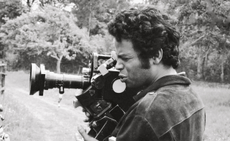Nan Goldin documentary is a gritty tale of addiction, resilience, and battles with the Sackler family
Released in the UK on 27 January, ‘All the Beauty and the Bloodshed’ by director Laura Poitras chronicles acclaimed photographer Nan Goldin’s complex life, work, and tireless activism to hold power to account.

The opening scene of All the Beauty and the Bloodshed begins in 2018 at the Egyptian Temple of Dendur in The Met Museum in New York. There, Nan Goldin is leading activists from P.A.I.N. (Prescription Addiction Intervention Now) in a protest in what was then the museum’s Sackler Wing, named after the pharmaceutical dynasty widely criticised for its role in America’s opioid crisis. They shout ‘shame’ and throw pill bottles, labelled with ‘prescribed to you by the Sackler Family’, into the museum’s indoor moat.
This sets the tone for a documentary that blends art and activism to blistering effect. Directed by Academy Award-winner Laura Poitras, the film became the second documentary to receive the coveted Golden Lion award at the Venice Film Festival in 2022 and currently sits on the shortlist for Best Documentary Feature Film at the 95th Academy Awards (winners announced 12 March 2023).
‘All the Beauty and the Bloodshed’: power and resistance

Poitras’ film deftly bookends and interweaves the life and work of Goldin with her tireless activism, stories of personal agony, and how she's used creativity as a tool for change. Power and resistance are recurring themes, past and present. Goldin’s early work – photographic chronicles of life in Boston’s gay and transgender communities – was met with hostility particularly, as she notes in the film, from male artists and gallerists.
In 1986, she curated the controversial landmark group exhibition ‘Witnesses: Against Our Vanishing’. The subject of national controversy, it was the first show to exclusively confront the Aids epidemic – during which Goldin lost close friends – and its social stigma.

Nan and Barbara holding hands; Goldin and her sister as children
The same year, Goldin would create her best-known work, The Ballad of Sexual Dependency (1986). It captures the off-guard extremes of human nature: the ecstasy, agony, love, sex, drugs and domestic violence in Goldin's social circle, all captured on 35mm slideshows. The deeply personal narrative continues as Goldin recounts how she was addicted to the opioid painkiller OxyContin in 2014. ‘My anger at the Sackler family is personal,’ she says in the film. ‘When you think of the profit of people’s pain, you can only be furious.’
At its heart, this is a film about family: Nan Goldin’s own family and childhood challenges, which involved her sister’s tragic suicide; and the familial 1980s communities and LGBT subcultures that Goldin immersed herself in and would base her most defining work on. And then came her battles with the Sackler family. The film chronicles how, since 2017, Goldin has been campaigning to scratch off the veneer of philanthropic nobility to expose the truth and hold power to account.

The Sacklers owned and operated Purdue Pharma, the (now-bankrupt) company that sold OxyContin, a high-strength, highly addictive painkiller that arguably fuelled the opioid epidemic. The opioid crisis led to the deaths of around half a million Americans over two decades through overdose (1999 – 2020, as detailed in a hearing published by the US government). Simultaneously, the Sackler family was prolific in offering handsome donations to arts institutions, its name stamped on wings and lobbies of global museums. Since Goldin’s activism began, global museums including the V&A, Tate, and the Louvre have dropped financial ties with the Sackler family. As Reuters reported in March 2022, the Sacklers paid $6 billion to resolve litigation alleging that OxyContin fuelled the US opioid crisis.
Wallpaper* Newsletter
Receive our daily digest of inspiration, escapism and design stories from around the world direct to your inbox.
Poitras’ epic ends back at The Met’s Egyptian Temple of Dendur. It’s now 2021, and the Sackler name has just been erased from the glass pane above the entrance. It’s a potent end to an agonising journey of loss, resilience and the journey to justice.
‘All the Beauty and the Bloodshed’ will be released in UK cinemas on 27 January 2023.
The documentary coincides with ‘This Will Not End Well’, Goldin’s major retrospective, which runs until 26 February 2023 at Moderna Museet, Stockholm, before travelling to the Stedelijk Museum in Amsterdam, the Neue Nationalgalerie in Berlin, and Pirelli HangarBicocca Milan.
Harriet Lloyd-Smith was the Arts Editor of Wallpaper*, responsible for the art pages across digital and print, including profiles, exhibition reviews, and contemporary art collaborations. She started at Wallpaper* in 2017 and has written for leading contemporary art publications, auction houses and arts charities, and lectured on review writing and art journalism. When she’s not writing about art, she’s making her own.
-
 Ruark Audio and Revo give the CD player revival a fresh spin
Ruark Audio and Revo give the CD player revival a fresh spinRuark Audio’s new R-CD100 and the Revo SuperCD are joined by two more quirky devices to revive those classic discs
By Jonathan Bell Published
-
 The new Ford Capri wants to tap a vein of Gen X nostalgia. Does it succeed?
The new Ford Capri wants to tap a vein of Gen X nostalgia. Does it succeed?We ask if the all-electric Ford Capri can capture the swagger of its much-loved but rather oafish predecessor
By Guy Bird Published
-
 Rug designer Sibylle de Tavernost’s homage to Fernand Léger
Rug designer Sibylle de Tavernost’s homage to Fernand LégerAbstract modern art, craft heritage and contemporary life fuse in Sibylle de Tavernost's new limited-edition rugs
By Harriet Thorpe Published
-
 Wu Tsang reinterprets Carmen's story in Barcelona
Wu Tsang reinterprets Carmen's story in BarcelonaWu Tsang rethinks Carmen with an opera-theatre hybrid show and a film installation, recently premiered at MACBA in Barcelona (until 3 November)
By Emily Steer Published
-
 Miu Miu’s Women’s Tales film series comes to life for Art Basel Paris
Miu Miu’s Women’s Tales film series comes to life for Art Basel ParisIn ‘Tales & Tellers’, interdisciplinary artist Goshka Macuga brings Miu Miu’s Women’s Tales film series for Art Basel Paris to life for the public programme
By Amah-Rose Abrams Published
-
 Don't miss these films at the BFI London Film Festival 2024
Don't miss these films at the BFI London Film Festival 2024The BFI has announced the lineup for their 68th festival, and it's a stellar one
By Billie Walker Published
-
 Brutalism in film: the beautiful house that forms the backdrop to The Room Next Door
Brutalism in film: the beautiful house that forms the backdrop to The Room Next DoorThe Room Next Door's production designer discusses mood-boarding and scene-setting for a moving film about friendship, fragility and the final curtain
By Anne Soward Published
-
 Jobbing actors and the anxious young man: 'In Camera' on the unrelenting nature of acting
Jobbing actors and the anxious young man: 'In Camera' on the unrelenting nature of actingDirector, Naqqash Khalid’s debut feature, 'In Camera,' explores identity politics through the lens of acting
By Zoe Whitfield Published
-
 How Amy Sall is highlighting the beauty of African cinema
How Amy Sall is highlighting the beauty of African cinemaAmy Sall is highlighting the cultural impact of African filmmakers with ‘The African Gaze: Photography, Cinema and Power’, published by Thames & Hudson
By Marris Adikwu Published
-
 The Substance may be grotesque, but it is not body horror
The Substance may be grotesque, but it is not body horrorThe Substance, Coralie Fargeat's sophomore feature film, has already been granted the moniker body horror, due its visceral imagery and mutations of the body
By Billie Walker Published
-
 New film, Hollywoodgate, finds out what really happened when the US left Afghanistan
New film, Hollywoodgate, finds out what really happened when the US left AfghanistanFilmmaker Ibrahim Nash’at’s Hollywoodgate follows Taliban soldier MJ Mukhtar and air force commander Mawlawi Mansour in the aftermath of America’s withdrawal in August 2021
By Zoe Whitfield Published